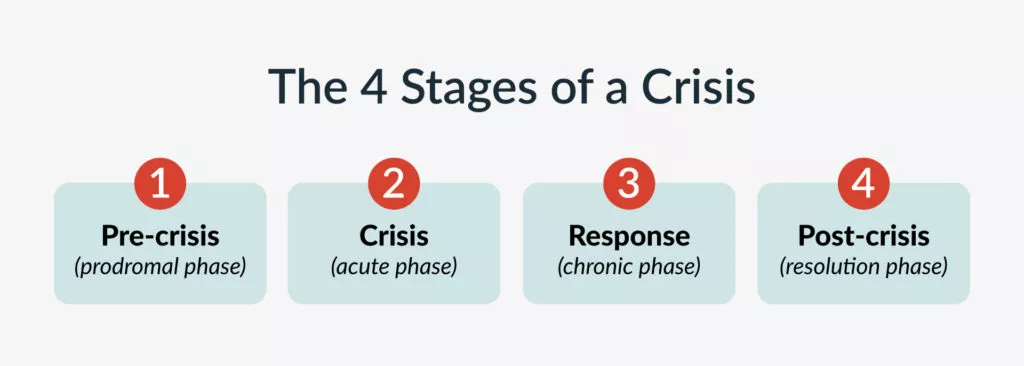
The 4 Stages of Crisis and How to Manage Them
A crisis might feel unpredictable, but it follows a pattern. Learn how to navigate emergencies by preparing for the four stages of a crisis.

Navigating a crisis can be incredibly intimidating for many business owners. And they are more common than most people realize. 96% of organizations report having experienced some disruption in the last two years. So, how can organizations better prepare themselves to react in times of crisis that can affect their people and operations?
One of the best strategies is to break it down into steps or stages. While a crisis might seem unpredictable, emergency events tend to follow the same four-stage pattern.
Brendan Monahan, Head of U.S. Resilience and Crisis Management for a major global pharmaceutical company, explained on an episode of The Employee Safety Podcast: “The truth is that whatever the crisis is, whatever the situation is, it’s going to follow something like a storyline. There’s always a pattern of escalation.”
Consider an earthquake or other natural disaster. While we may think of these disasters as one-time emergency events, they are composed of four distinct stages. From pre-crisis through recovery, each of these stages requires a different response. Using the phases of a crisis as the foundation for your disaster response planning efforts, you can confront less predictable crises more successfully.
In this article, we’ll explore the four stages or steps of crisis management and share strategies for navigating each stage to keep employees safe and maintain business continuity. We’ll also share how and what to communicate during each phase.
Stages of Crisis Events |
Stage 1: Prodromal phase (pre-crisis stage) |
Stage 2: Acute phase (crisis stage) |
Stage 3: Chronic phase (response stage) |
Stage 4: Resolution phase (post-crisis stage) |
The 4 Stages of Crisis Management

While crises can span a wide range of potential scenarios, one key to business resilience is developing a crisis-agnostic response plan. You can take an all-hazards approach when developing your crisis management plan, and it’s essential to creating a resilient business that can withstand any type of disaster.
While there are multiple crisis management models out there, the four stages of a crisis identified below are among the most popular:
Three vs. four stages of crisis
There are different viewpoints about the number of stages of a crisis. Some frameworks use the four we have laid out here, whereas others follow a three-stage structure that includes pre-crisis, crisis response, and post-crisis. These are simply different ways to look at crisis management, and your organization should follow the structure that works best in context.
Stage 1: Prodromal phase (pre-crisis stage)

This first stage occurs before the crisis itself hits. In many cases, this pre-crisis stage will be like any other day. Some crises—like active shooter events, cyberattacks, or natural disasters—can happen anytime, without prior warning. For other events, your crisis management team may be able to pick up on warning signs. Crises like extreme weather events or transportation disruptions may bring an element of forewarning, such as weather warnings or press and social media coverage.
Consider this a preparatory stage, where you look for potential crises that may affect your company. If you identify warning signs, you should take steps to reduce the impact of the crisis—or prevent it entirely.
What to do during the pre-crisis stage: Preparedness and mitigation
If you don’t yet have a crisis management plan, now is the time to develop one—as a priority. Taking an all-hazards approach to emergency planning and creating a robust, crisis-agnostic plan is the best way to ensure you’re ready for any event. What will your crisis communication strategy be if you need to communicate urgent information? How will you stay connected to your employees to ensure their safety and well-being? Understanding the answers to these questions now—before the crisis—can ensure you’re not left scrambling when disaster strikes.
The best way to organize all of this information is with a crisis management template. This template allows you to centralize your crisis management strategy in one document and distribute it to those who need it.

At this stage, any organization should also be proactively monitoring potential threats. A solid risk mitigation plan that incorporates regular threat intelligence reports can help you quickly discover potential threats that may impact where employees live, work, or travel. Through active monitoring, for example, you may identify civil unrest in a country your employees are due to visit for business. Canceling or modifying their trip could prevent this event from becoming a crisis for your business.
This phase is also the time to create emergency kits containing whatever items you’ve identified as important. If you already have your kits prepared, check on them to ensure any items with expiration dates are replenished as necessary.
You can also incorporate drills and tabletop exercises into this stage. With active shooters posing an increasing threat within the U.S., for example, drills and training on strategies like “Run, Hide, Fight” can help reduce the risk of injuries should an active shooter incident occur. Simulation exercises present an opportunity to ensure all employees understand what actions they need to take in the event of an emergency.
The benefits of planning for all four crisis phases
It might be tempting to plan out your response during the acute phase/crisis stage since that is when the crisis is actually going on. However, planning for all the stages of a crisis can significantly improve your organization’s ability to respond and recover from an event. Effective planning lets you better understand your risks, establish clear communication channels, and develop actionable response plans. These preparations will minimize a crisis’s disruption and foster better business resilience. If you’re worried about the time investment of planning for all four stages, you can use a crisis management plan template to streamline your planning and ensure you cover all your bases in one document.
Stage 2: Acute phase (crisis stage)

The crisis phase is when your organization notices the first signs of a crisis unfolding. Also known as the acute phase, this is the point of no return—you can no longer prevent the crisis from happening. Now, your focus needs to turn to risk assessment and risk management so that you can rapidly respond and mitigate the event’s impact. While often the most intense phase, the acute stage is generally the shortest of the four stages.
What to do during the crisis stage: Assess, activate, and alert
During this acute phase, your first goal is to assess the situation, with three main questions to answer:
- What is the specific threat or crisis?
- Who is involved or at risk?
- Which response plan should we activate?
Once you’ve identified the crisis, who’s affected, and which plan to activate, you need to alert any employees who are at risk. Emergency communication software allows you to quickly send notifications through multiple communication channels—such as email, phone calls, text messages, and desktop alerts—to ensure every employee in harm’s way receives the time-sensitive information they need to stay safe.
For example, after the Thales Group detects and assesses a threat, the organization uses its emergency communication system to activate the appropriate response plan within minutes. Judy Weber, Thales Group’s Vice President of Operations, adds, “It would be impossible to manually monitor for all the potential threats that could impact every one of our sites. Getting real-time alerts when an incident happens near one of our sites and seeing exactly who might be impacted allows us to act faster in any situation.”
Stage 3: Chronic phase (response stage)

After you activate your response plan, the crisis moves into its response stage as you deploy the resources needed to address the emergency. Now, your crisis team members are taking action.
How long this stage lasts depends on the type of crisis. For some events, like a snowstorm, it could be a matter of days. For others, like a public health emergency, the response time could be much longer. Few businesses could have predicted that their crisis management teams would still be responding to the COVID-19 pandemic more than two years later.
What to do during the response stage: Take action
By now, you’re dealing with the effects of the crisis and attempting to take control. Depending on the type of emergency, you may need to mobilize emergency response resources, including first responders.
For example, in the event of a hazardous spill in your facility, you must call 911, evacuate the building, and ensure you can account for all employees. In the case of an IT outage, you may need to contact service providers to determine service restoration time and decide whether to send employees home to work remotely. Fire from broken gas lines is one of the greatest dangers following an earthquake. After the shaking subsides, it’s essential to shut off the gas service immediately if you smell gas or suspect a leak to prevent a secondary fire emergency.
During this phase, swift decision-making from stakeholders and your crisis response team will help you effectively manage the situation and mitigate additional risks.
Stage 4: Resolution phase (post-crisis stage)

At this stage, the crisis can be considered over as you transition from crisis management back to business as usual. Employees return to work, and normal business operations can start to resume. Depending on the type of crisis, this final crisis resolution stage can take days, weeks, or even months.
What to do during the post-crisis stage: Recover
During this crisis phase, you may need to assess and repair damage to buildings or other assets so the business can resume normal operations. The recovery phase should also consider any impact the crisis may have had on your employees’ mental health and well-being. They will need to be taken care of, and their return to work must be arranged using suitable timelines for each individual. Employers can provide counseling or additional support as required. If the crisis has involved negative media coverage, your public relations department may need to work on rebuilding your reputation.
At this stage, the crisis can be considered over as you transition from crisis management back to business as usual. Employees return to work and normal business operations can start to resume. Depending on the type of crisis, this final crisis resolution stage can take days, weeks, or even months.
At the same time, your crisis response team should assess the overall business response to the crisis. Once you’ve evaluated the effectiveness of your response, build modifications into your emergency response plans and pass any relevant information on to your employees.
Now, the four-stage cycle moves back into the first stage, the pre-crisis stage, as you begin monitoring and preparing for future crises once more.
—Brendan Monahan, Head of U.S. Resilience and Crisis Management for a major global pharmaceutical company
How to Integrate Communication Into Each Stage of a Crisis
Effective crisis communication planning is critical to crisis management, requiring thought and preparation. During a crisis situation, reactive messaging can do more harm than good. When it comes to effective communication, each stage of the crisis needs a slightly different approach:
Pre-crisis: Demonstrate your preparedness
Before a crisis occurs, your employees will want to know that you’re taking steps to protect them should a crisis hit. Communicate your plans across the organization and run drills to assess their effectiveness. Ask for feedback and adjust your plans as necessary.
Crisis: Alert your team
Now is the time to alert your employees to the threat. Whatever the size of your business, using a mass notification system is an effective way to ensure you can reach affected employees as fast as possible. A solution that enables you to segment messages by location, function, or other relevant attributes is vital to ensuring employees only receive notifications applicable to them. The last thing you want in an actual emergency is employees overlooking your message because of notification fatigue.
Response: Communicate and update
The response phase can be fluid, so you must communicate your plans with employees and liaise with stakeholders as the crisis develops. Share any adjustments or adaptations to your strategy where necessary. An emergency communication platform with event page functionality can help consolidate all event-specific information into one central hub that employees can access whenever needed.
Post-crisis: Assess and evaluate
Once the crisis is over, your crisis management team should assess and evaluate the response and decide what you would do differently in the future. Feedback from employees can also help inform this stage. Communicate with employees about any changes to your crisis management plan or drills resulting from these evaluations.
A Framework for Improved Crisis Management
Knowing that the lifecycle of any crisis develops across four distinct phases will help you create an effective crisis management plan that protects your people and business. With a deeper understanding of the four stages of a crisis—pre-crisis, crisis, response, and recovery— you’ll be able to identify which stage of a crisis you are in at any moment. As a result, you and your employees will be better equipped to tailor your actions and decisions appropriately, ultimately enhancing safety and business resilience.



![11 Steps to Creating an Effective Emergency Response Plan [+ Template]](https://www.alertmedia.com/wp-content/uploads/2023/10/Blog-Emergency-Response-Plan.webp)
